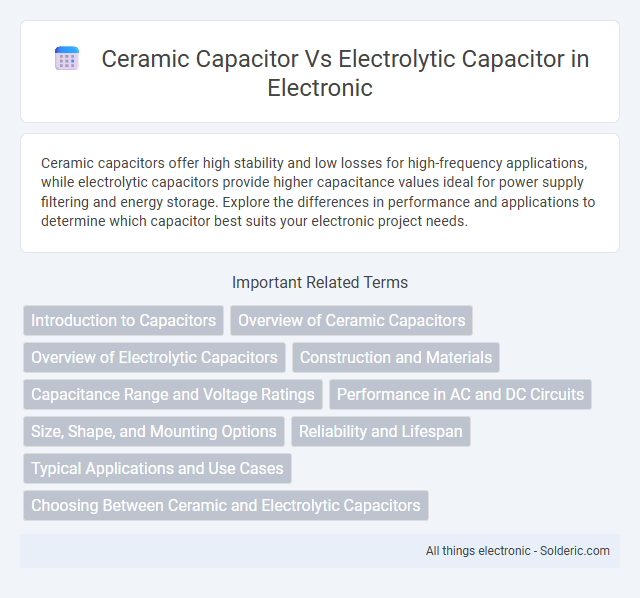Ceramic capacitors offer high stability and low losses for high-frequency applications, while electrolytic capacitors provide higher capacitance values ideal for power supply filtering and energy storage. Explore the differences in performance and applications to determine which capacitor best suits your electronic project needs.
Comparison Table
| Feature | Ceramic Capacitor | Electrolytic Capacitor |
|---|---|---|
| Dielectric Type | Ceramic | Electrolyte (Liquid or Gel) |
| Capacitance Range | 1 pF to 100 uF | 1 uF to 10,000 uF |
| Voltage Range | Up to 50 kV | Up to 500 V |
| Polarity | Non-polarized | Polarized (Positive and Negative terminals) |
| Equivalent Series Resistance (ESR) | Low | Higher (generally) |
| Temperature Stability | Excellent (Class 1 ceramics) | Poorer compared to ceramics |
| Applications | High-frequency circuits, decoupling, filtering | Power supply filtering, bulk energy storage |
| Size | Smaller for same capacitance | Larger for same capacitance |
| Lifetime | Longer, stable over time | Shorter, can dry out and degrade |
| Cost | Generally lower per uF | Higher per uF |
Introduction to Capacitors
Capacitors store electrical energy and regulate voltage flow in electronic circuits, with ceramic and electrolytic types being the most common. Ceramic capacitors offer low capacitance values, high stability, and low equivalent series resistance (ESR), making them ideal for high-frequency applications and noise filtering. Electrolytic capacitors provide higher capacitance in a compact size and are suitable for power supply smoothing and bulk energy storage, but they typically have higher ESR and shorter lifespans compared to ceramic capacitors.
Overview of Ceramic Capacitors
Ceramic capacitors are non-polarized components made from ceramic materials that provide high stability and low inductance, ideal for high-frequency applications. They are available in various capacitance values, typically ranging from a few picofarads to several microfarads, and are known for their low cost and reliability. You can rely on ceramic capacitors for decoupling, filtering, and timing circuits where small size and high performance are critical.
Overview of Electrolytic Capacitors
Electrolytic capacitors store energy using an electrolyte, enabling high capacitance values in compact sizes, typically ranging from 1 uF to several thousand uF with voltage ratings from 6.3V to 450V. They exhibit polarized behavior, requiring correct polarity during installation to avoid damage or failure, and are commonly used in power supply filtering and audio applications due to their high capacitance and low cost. Compared to ceramic capacitors, electrolytic capacitors generally have higher equivalent series resistance (ESR) and lower frequency response but are preferred for bulk energy storage and smoothing voltage fluctuations in DC circuits.
Construction and Materials
Ceramic capacitors consist of multiple layers of ceramic dielectric material with metal electrodes, offering stable performance and low equivalent series resistance (ESR). Electrolytic capacitors feature an aluminum or tantalum anode, a liquid or solid electrolyte as the cathode, and a thin oxide layer acting as the dielectric, enabling high capacitance values but with higher ESR and limited lifespan. The distinct construction and materials determine their voltage ratings, capacitance ranges, and suitability for different circuit applications.
Capacitance Range and Voltage Ratings
Ceramic capacitors typically offer capacitance values ranging from a few picofarads (pF) up to several microfarads (uF), with voltage ratings commonly between 16V and 1kV, making them ideal for high-frequency, low-capacitance applications. Electrolytic capacitors provide significantly higher capacitance values, from 1uF up to thousands of microfarads (uF), and voltage ratings generally span from 6.3V to 500V, suited for power supply filtering and bulk energy storage. Your choice depends on the required capacitance and voltage rating for the application's performance and reliability.
Performance in AC and DC Circuits
Ceramic capacitors excel in high-frequency AC circuits due to their low equivalent series resistance (ESR) and stable capacitance, making them ideal for filtering and decoupling applications. Electrolytic capacitors, with higher capacitance values, are preferred in DC circuits for bulk energy storage and smoothing voltage, though their performance degrades at higher frequencies. Understanding these characteristics helps optimize your circuit design for both AC and DC performance demands.
Size, Shape, and Mounting Options
Ceramic capacitors are typically small, disc-shaped or rectangular components often used in surface-mount technology (SMT) applications, making them ideal for compact, high-frequency circuits. Electrolytic capacitors tend to be larger, cylindrical with radial or axial leads, designed primarily for through-hole mounting, suited for applications requiring high capacitance values. Your choice depends on space constraints and mounting preferences, with ceramic capacitors offering more flexibility for miniaturized, surface-mounted designs.
Reliability and Lifespan
Ceramic capacitors exhibit superior reliability and longer lifespan due to their stable dielectric material and low equivalent series resistance (ESR), which reduces heat generation. In contrast, electrolytic capacitors have a shorter lifespan because they rely on a liquid electrolyte that can dry out or leak, leading to failure over time. Proper operating conditions and voltage ratings extend both types' longevity, but ceramics generally outperform electrolytics in long-term stability.
Typical Applications and Use Cases
Ceramic capacitors excel in high-frequency applications such as RF circuits, decoupling, and filtering due to their low inductance and stable performance over temperature. Electrolytic capacitors are commonly used in power supply smoothing, audio circuits, and bulk energy storage, where high capacitance values and voltage handling are essential. Your choice depends on the application's frequency range, capacitance requirement, and size constraints, with ceramics favored for small, high-frequency roles and electrolytics for larger, low-frequency energy storage.
Choosing Between Ceramic and Electrolytic Capacitors
Choosing between ceramic and electrolytic capacitors depends on factors like capacitance value, voltage rating, and application needs. Ceramic capacitors excel in high-frequency circuits due to low ESR and ESL, while electrolytic capacitors offer higher capacitance and voltage tolerance for power supply filtering. Understanding your circuit's requirements helps you select the optimal capacitor type for stable and efficient performance.
Ceramic capacitor vs electrolytic capacitor Infographic

 solderic.com
solderic.com